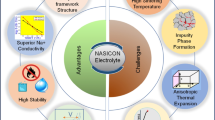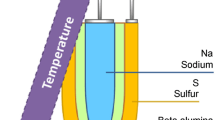Abstract
A variety of rechargeable Na batteries are under development for use in energy storage systems. For these batteries, a Na-ion conducting solid electrolyte is desired. One such electrolyte under consideration is NaSICON (Na Super Ionic Conductor). One important aspect of the NaSICON electrolytes that has been overlooked is their mechanical properties. Such information is required if NaSICON has to be used as a solid electrolyte in rechargeable Na batteries that exhibit long life cycle and high power. This paper reviews the elastic, plastic, and fracture properties of NaSICON electrolytes. Young’s modulus values for NaSICON range from ~ 56 to 97 GPa with Poisson’s ratio ~ 0.26. Hardness values determined by micro-indentation for NaSiCON are 4.4–4.9 GPa. The value of the Gilman-Chin parameter suggests the bonding in NaSICON is covalent. As a result of its covalent bonding, NaSICON exhibits a high Peierls which leads to low fracture toughness, with KIC values ~ 1–1.5 MPa m0.5. The fracture strength of NaSICON is between 50 and 110 MPa and is controlled by the amount and size of the second-phase ZrO2 particles.
Similar content being viewed by others
References
Marinaro M, Dsoke S (2022) Advances in nanomaterials for lithium-ion/post-lithium-ion batteries and supercapacitors. Nanomaterials 12:12152512
Manarin L, Corsini F, Trano S, Lucia F, Fagiolari L, Amicic J, Francia C, Bodoardo S, Turri S, Bella F, Griffini G (2022) Cardanol-derived epoxy resins as biobased gel polymer electrolytes for potassium-ion conduction. ACS Appl Polymer Mater 4:3855–3865
Bella F, Deluca S, Fagiolari L, Versaci D, Amici J, Francia C, Bodoardo S (2021) An overview on anodes for magnesium batteries: challenges towards a promising storage solution for renewables. Nanomaterials 11:810–820
Khan A, Muhammad I, Ahmad R, Ahmad I (2021) Penta graphene: a superior anode material for Mg-ion batteries with high specific theoretical capacity. Ionics 27:4819–4828
Polu AR, Kumar R, Rhee HW (2015) Magnesium ion conducting solid polymer blend electrolyte based on biodegradable polymers and application in solid-state batteries. Ionics 21:125–132
Tsai C-L, Lan T, Dellen C, Ling Y, Ma Q, Fattakhova-Rohlfing D, Guillon O, Tietz F (2020) Dendrite-tolerant all solid-state sodium batteries and an important mechanism on metal self-diffusion. J Power Sources 476:22866
Kim Y, Kim H, Park S, Seo I, Kim Y (2016) Na-ion conducting ceramic electrolyte for rechargeable seawater batteries. Electrochim Acta 191:1–7
Kim J, Seung HJ, Bhavaraju S, Eccleston A, Kang SO (2015) Low temperature performance of sodium-nickel chloride batteries with NaSICON electrolyte. J Electroanalytical Chem 759:201–206
Modak S, Valle J, Tseng KT, Sakamoto J, Kwabi DG (2022) Correlating stability and performance of NaSICON membranes for aqueous redox flow batteries. ACS Appl Mater Interfaces 14:19332–19341
Chu WF, Tsagarakis ED, Metzing T, Weppner W (2003) Fundamental and practical aspects of CO2 sensors based on Nasicon electrolytes. Ionics 9:321–328
Kotzeva VP, Kumar RV (2003) Nasicon sensor for NO detection in the automotive exhaust. Ionics 9:127–133
Fuentes RO, Figueiredo F, Marques FMB, Franco G (2002) Optimized nasicon ceramic for Na+ sensing. Ionics 8:383–390
Siebert E, Fabry P (1999) Nasicon type ionic conductors for alkali ion sensing. Ionics 5:261–268
Go W, Kim J, Pyo J, Wolfenstine JB, Kim Y (2021) Investigation on the structure and properties of Na3.1Zr1.55Si2.3P0.7O11 as a solid electrolyte and its application in a seawater battery. ACS Appl Mater Interfaces 13:52727–52735
Goodenough JB, Hong HP, Kafalas JA (1976) Fast Na+-ion transport in skeleton structures. Mater Res Bull 11:203–220
Valle JM, Huang C, Tatke D, Wolfenstine J, Go W, Kim Y, Sakamoto J (2021) Characterization of hot-pressed von Alpen type NASICON ceramic electrolytes. Solid State Ionics 369:115712
Kuriakose AK, Wheat TA, Ahmad A, Dirocco J (1984) Synthesis, Sintering, and Microstructure of Nasicons. J Am Ceram Soc 67:179–183
Fergus JW (2012) Ion transport in sodium ion conducting solid electrolytes. Solid State Ionics 227:102–112
Guin M, Tietz F (2016) Survey of the transport properties of sodium superionic conductor materials for use in in sodium batteries. J Power Sources 273:1056–1064
Jolly AG, Cohn G, Hitz GT, Wachsman ED (2015) Improving the ionic conductivity of NASICON through aliovalent cation substitution of Na3Zr2Si2PO12. Ionics 21:3031–3038
Kravchyk KV, Karabay DT, Kovalenko MV (2022) On the feasibility of all-solid-state batteries with LLZO as a single electrolyte. Sci Rep 12:1177
Raj R, Wolfenstine J (2017) Current limit diagrams for dendrite formation in solid-state electrolytes for Li-ion batteries. J Power Sources 343:119–126
Virkar AV (1981) On some aspects of breakdown of β ″-alumina solid electrolyte. J Mat Sci 16:1142–1150
Davidge RW, Evans AE (1970) The strength of ceramics. Mat Sci Eng 6(5):281–298
Nonemacher JF, Naqash S, Tietz F, Malzbender J (2019) Micromechanical assessment of Al/Y-substituted NASICON solid electrolytes. Ceram Inter 45:21308–21314
Gao Z, Yang J, Li G, Ferber T, Feng J, Li Y, Fu H, Jaegermann W, Monroe CW, Huang Y (2022) TiO2 as second phase in Na3Zr2Si2PO12 to suppress dendrite growth in sodium metal solid-state batteries. Adv Energy Mater 12:2103607
Davidge RW (1979) Mechanical behavior of ceramics. Cambridge University Press, Cambridge
Barsum MV (1997) Fundamentals of ceramics. The McGraw Hill Companies Inc, New York
Deng Z, Wang Z, Chu IK, Luo J, Ong SP (2016) Elastic properties of alkali superionic conductor electrolytes from first principle calculations. J Electrochem Soc 163(2):A67–A74
Quinn GD, Bradt RC (2007) On the Vickers indentation fracture toughness test. J Am Ceram Soc 90(3):673–680
Broitman E (2017) Indentation hardness measurements at macro- micro- and nanoscale: A critical overview. Trib Lett 65:23
Schiffmann KI (2011) Determination of fracture toughness of bulk materials and thin films by nanoindentation: comparison of different models. Phil Mag 91(7–9):1163–2117
Dey A, Mukhopadhyay AK (2011) Fracture toughness of microplasma-sprayed hydroxyapatite coating by nanoindentation. Int J Appl Ceram Technol 8(3):572–590
Ran L, Baktash A, Li M, Yin Y, Demir B, Lin T, Li M, Rana M, Gentle I, Wang L, Searles DJ, Knibbe R (2021) Sc, Ge co-doping NaSICON boosts solid-state sodium ion batteries. Energy Storage Mater 40:282–291
Bouquin O, Perthius H, Colomban Ph (1985) Low-temperature sintering and optimal physical properties: a challenge-the NaSICON ceramics case. J Mat Sci Lett 4:956–959
BoquszV KF, Jaukowski W (1983) Influence of doping on some physical properties of NaSICON. Solid State Ionics 9&10:803–808
Krok F (1987) Influence of sintering conditions on chemical composition of NaSICON. Solid State Ionocs 24:21–28
Krell A (1998) A new look at the influences of load, grain size and grain boundaries on the room temperature hardness of ceramics. Inter J Refract Metal Hard Mater 16:331–335
Gilman JJ (1960) The plastic resistance of crystals. Aust J Phys 13(2):327–346
Chin GY, Wernick JH, Geballe TG, Mahajan S, Nakahara S (1978) Hardness and bonding in A15 superconducting compounds. Appl Phys Lett 33(1):103–105
Wolfenstine J, Allen JL, Sakamoto J, Siegel DJ, Choe H (2018) Mechanical behavior of Li-on conducting crystalline oxide-based solid electrolytes: a brief review. Ionics 24:1271–1276
Rice RW (1996) Grain size and porosity dependence of ceramic fracture energy and toughness at 22 degrees C. J Mater Sci 31(8):1969–1983
Rice RW, Freiman SW, Becher PF (1981) Grain-size dependence of fracture energy in ceramics: I, experiment. J Am Ceram Soc 64(6):345–350
Green DJ (1985) Transformation toughening and grain size control in β”-Al2O3/ZrO2 composites. J Mat Sci 20:2639–2646
Lange FF, Davis BI, Raleigh DO (1983) Transformation strengthening of β”-Al2O3 with tetragonal ZrO2. J Am Ceram Soc 66:C50–C51
Xia K, Langdon TG (1994) The toughening and strengthening of ceramic materials through discontinuous reinforcement. J Mat Sci 29:5219–5231
Petrovic JJ, Honnell RE, Mitchell TF, Wade RK, McClellan KJ (1991) ZrO2-reinforced MoSi2 matrix composites. Ceram Eng Sci Proc 12:1633–1642
Chiang YM, Birnie D, Kingery WD (1997) Physical ceramics. John Wiley & Sons, New York
Callister WD Jr (2005) Fundamentals of materials science and engineering. John Wiley & Sons, New York
Yde-Anderson S, Lundsgaard JS, Moller L, Engell J (1984) Properties of NaSICON Electrolytes prepared from alkoxide derived gels: ionic conductivity, durability in molten sodium and strength test data. Solid State Ionics 14:73–79
Gordon RS, Miller GR, NcEntire BJ, Beck ED, Rasmussen JR (1981) Fabrication and characterization of NaSICON electrolytes. Solid State Ionics 3/4:243–248
Davidge RW, Green TJ (1968) Strength of two-phase ceramic/glass materials. J Mat Sci 3:629–634
Lange FF (1973) Effect of microstructure on the strength of Si3N4-SiC composite system. J Am Ceram Soc 56:445–450
Green DJ, Maki DR, Nicholson PS (1974) Microstructural development in partially stabilized ZrO2 in the system CaO-ZrO2. J Am Ceram Soc 57:136–139
McEntire BJ, Bartlett RA, Miller GR, Gordon RS (1983) Effect of decomposition on the densification and properties of NaSICON ceramic electrolytes. J Am Ceram Soc 66:738–742
Jackman SD, Cutler RA (2012) Effect of microcracking on the ionic conductivity of LATP. J Power Sources 218:65–72
Funding
This work was partially supported as part of the Joint Center for Energy Storage Research, an Energy Innovation Hub funded by the US Department of Energy, Office of Science, Basic Energy Sciences.
Author information
Authors and Affiliations
Corresponding author
Ethics declarations
Conflict of interest
The authors declare no competing interests.
Additional information
Publisher's note
Springer Nature remains neutral with regard to jurisdictional claims in published maps and institutional affiliations.
Rights and permissions
Springer Nature or its licensor (e.g. a society or other partner) holds exclusive rights to this article under a publishing agreement with the author(s) or other rightsholder(s); author self-archiving of the accepted manuscript version of this article is solely governed by the terms of such publishing agreement and applicable law.
About this article
Cite this article
Wolfenstine, J., Go, W., Kim, Y. et al. Mechanical properties of NaSICON: a brief review. Ionics 29, 1–8 (2023). https://doi.org/10.1007/s11581-022-04820-z
Received:
Revised:
Accepted:
Published:
Issue Date:
DOI: https://doi.org/10.1007/s11581-022-04820-z




